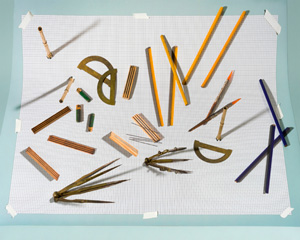On a quiet summer day, allow me to catch up with a review that somehow I never managed to post. John Houck has taken up painting. He has been turning more and more to oil on linen, a seeming contrast with the clarity of his photography. Yet he has brought elements of painting to his work longer still.
One series incorporates fine variations that make a single color layered, textured, and bright. He also folds the paper across more or less the middle, both vertically and horizontally, and the pleats suggest fields of color even in monochrome. Other prints have elements of still life, including drafting tools, but also touches of paint.
Painting has long haunted the medium. Photography had to prove itself an art for those who worry about such things, like the Victorian staged portraits of its early years, and the AIPAD art fair still bends over backward to assure collectors that it is arty enough. When it comes down to it, the “decisive moment” for Henri Cartier-Bresson, of a figure poised in midair or the perfect Paris street, is also an artful one. Houck’s still life, in turn, recalls Synthetic Cubism in its layers of paper defining the picture plane, while the Met has struggled to claim Cubism for the “trompe l’oeil tradition” in Baroque painting. Never mind that Georges Braque and Pablo Picasso were conspiring to throw paint and tradition to the winds. Only now, though, does Houck devote a show to painting and nothing else, at Candice Madey through March 2.
If paintings still come as a surprise, it is because he retains his old medium’s clarity without the precision. He has given up the self-referential signs of studio practice for landscape, and what strange landscapes these are. To be sure, while he appeared in “Public, Private, Secret” at the International Center of Photography back in 2017, he keeps nothing secret. These are perilous landscapes indeed, with sharp drop-offs from the curved edge of foreground cliffs. Volcanos tower above, both dormant and wildly erupting, filling the air with near vertical clouds of ash. Just as obvious is the thick white cloud taking over a painting.
Still, the clearer he becomes, the less he promises to make sense. In no way could these elements share a landscape, and he relishes it. Leaps into depth defy human perspective as well. Railroad tracks taper and curve unnaturally as they extend into depth. Colors are no more reasonable, from the purple cliffs to a flat, red sky. It could be no more than a curtained backdrop, and other elements cast their shadows on earth and sky.
 Those objects descending from chains are, it turns out, family heirlooms. (Maybe Houck has his family secrets after all.) They are bells, although their edges, like the top edge of a royal crown, surely cut too close for them to ring out all that loudly. The entire landscape seems strangely quiet in the midst of eruptions, and the tracks do not hold an onrushing train. He adopts relatively mute colors as well and, as in his photos, a disdain for high drama. The show is, after all, “Perfect Temperature Lava.”
Those objects descending from chains are, it turns out, family heirlooms. (Maybe Houck has his family secrets after all.) They are bells, although their edges, like the top edge of a royal crown, surely cut too close for them to ring out all that loudly. The entire landscape seems strangely quiet in the midst of eruptions, and the tracks do not hold an onrushing train. He adopts relatively mute colors as well and, as in his photos, a disdain for high drama. The show is, after all, “Perfect Temperature Lava.”
If James Welling in Tribeca makes photography look like brushwork, give or take the pixels, Houck likes painting for its refusal to stay put in the physical present. (At the gallery’s other space across the street, Yi Xin Tong insists on his media’s presence with acrylic, clay, cuts, and glue.) He builds landscapes the old-fashioned way, from shaded drawing or underpainting, but they owe more to the imagination than to observation. Paradoxically, the bells are real and observed. The lack of drama can leave me wondering, and I may recoil at a landscape’s mysteries. Yet he is still puzzling out the remembered and the seen.
Read more, now in a feature-length article on this site.
